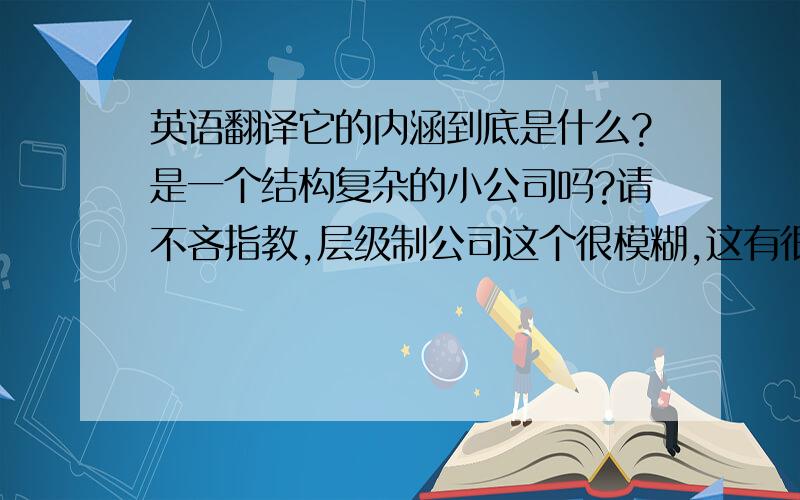英语翻译它的内涵到底是什么?是一个结构复杂的小公司吗?请不吝指教,层级制公司这个很模糊,这有很多种的,具体这个应该是使用一种imformation age模式运行的公司.可不知道具体怎么翻译?
来源:学生作业帮助网 编辑:作业帮 时间:2024/11/28 11:07:59

英语翻译它的内涵到底是什么?是一个结构复杂的小公司吗?请不吝指教,层级制公司这个很模糊,这有很多种的,具体这个应该是使用一种imformation age模式运行的公司.可不知道具体怎么翻译?
英语翻译
它的内涵到底是什么?是一个结构复杂的小公司吗?请不吝指教,
层级制公司这个很模糊,这有很多种的,具体这个应该是使用一种imformation age模式运行的公司.可不知道具体怎么翻译?
英语翻译它的内涵到底是什么?是一个结构复杂的小公司吗?请不吝指教,层级制公司这个很模糊,这有很多种的,具体这个应该是使用一种imformation age模式运行的公司.可不知道具体怎么翻译?
层级制公司
具体的我也说不明楚,我在网上看到一个短文是关于这个的,复制如下,希望对你有帮助.
C1.In the hierarchical companies of the 1960s and 1970s, information moved slowly and channels for communication was limited.
Over the past few years, however, large companies have come under ever-increasing pressure to collect, process and distribute information more quickly in order to compete with smaller, more nimble rivals. The key challenge facing any sizeable organization
today is how to achieve responsiveness without losing the control inherent in a hierarchical structure.
C2.All types of organization are controlled thru two sets of processes. Operating processes
define how a company produces, sells, distributes and supports its products and service. Management processes define how a company directs, coordinates and controls these operations. Typical management processes include planning, budgeting and human resource management.
C3. Traditional hierarchical organizations control operating processes through standardization of jobs. These jobs are separated into sequential steps and carried out under direct supervision. However, the lines workers lack both the authority and motivation to improve these routine tasks and are limited by their local view of the business. Management processes in such companies are also hampered by the time it takes to recognize that change is needed. Thus, hierarchical control is only truly effective in relatively stale business environments where change happens slowly.
C4.Entreprenurial organizations, on the other hand, allow fast response without any loss of control. Daily personal interaction between the owner and employees ensures flexibility and responsiveness, while instant feedback ensures effective controls. However, as the company becomes larger and complex, this control breaks down and more structured operating and management processes are required.
C5.Information age organizations can manage the complexity of the large hierarchical structure without losing the speed of the entrepreneurial start-up. IT plays a critical role. It co-ordinates complex fast-cycle operating process and, more importantly, gives decision-makers quick access to detailed, real-time information about operations and market performance. Once all this information is flowing, empolyees can quickly evaluate their decisions and continually refine both strategy and operations. Organizational control then becomes a dynamic, information-enabled learning process rather than a static monitoring system.
C6.However, although IT makes the "big small" company possible, it cannot motivate people to use information in order to act on behalf the organisations. The challenge for the organization is therefore to ensure that the managers and the employees share the same perspective on the business and are motivated to accomplish the same goals.
--That’s all.
尝试翻译:
C1.层级制公司在1960-1970年间,信息传递缓慢,各渠道交流有限.然而,在过去的一些年里,那些大公司为了和小而灵活的公司竞争,已经感到前所未有的压力,使得它们更注重并加紧去收集,处理与分发相关信息.当今任何具规模的机构均面临的主要挑战是如何在层级组织中不失内部控制的同时成功做出灵活的应变.
C2.所有的机构都通过两种方式来控制.运营程序规定了公司如何生产,销售,分送,以及对产品和销售服务的支持.管理程序则规定了一个公司如何引导,协调以及控制公司的运营程序.典型的管理方式包括计划,预算,和人力资源管理.
C3.传统的层级组织通过标准化的工作程序来控制运营程序.这些工种是序列分开的,直接受上级领导.然而,这种模式使得一线员工缺乏权利与激励来改进日常工作,而且容易受地方观念的局限.同样,管理程序发展也受到阻碍,因为它们花费很多的时间才能认识到需要改变.所以说,层级控制制度只有针对于相对稳定经营的公司(经营环境很少有变化)才比较有效果.
C4.从另一方面来讲,这种模式,能够通过迅速回馈来进行完整无损的控制.雇主与雇员间的日常交流有助于企业做出灵活有效的反应,同时,迅速反馈有助于高效控制.然而,当企业发展到更具规模与复杂化的,这种模式就无法满足了.企业此时更需要更深层次的运营程序与管理模式.
C5.信息时代,企业能够不失快速发展企业地管理好更复杂化的层级组织.其中,IT扮演了重要的角色.它协调了虽复杂但快速反馈的运营模式,更重要的是,它使得决策者可以迅速获取详细的实时信息(运营模式,市场反应).这样,信息传递畅通,雇员们可以迅速评价他们的决定是否正确,从而不断地改进战略与运营模式.从而,企业组织的控制转变成动态的信息学习过程而不是静态的监控系统.
C6.尽管IT使得大企业细化管理成为可能,但是,这并不能激励员工使用信息是为了企业的发展.这种模式下,企业所面临的挑战是:能否保证雇主与员工间的对商业运作的理解是一致的,并且能够激励员工完成共同的目标.